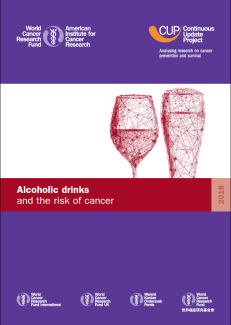Alcoholic Drinks and the Risk of Cancer

Source: World Cancer Research Fund/American Institute for Cancer Research.
Continuous Update Project Expert Report 2018. Alcoholic Drinks and the Risk of Cancer. Available at dietandcancerreport.org
Executive summary
Background and Context:
In this part of the Third Expert Report from our Continuous Update Project (CUP) – the world’s largest source of scientific research on cancer prevention and survivorship through diet, nutrition and physical activity – we analyse global research on how consuming alcoholic drinks affects the risk of developing cancer. This includes new studies as well as those included in the 2007 Second Expert Report, Food, Nutrition, Physical Activity, and the Prevention of Cancer: a Global Perspective. Alcohol is the common term for ethanol, which is produced when sugars are broken down by yeasts to release energy. This process, known as fermentation, is used to produce alcoholic drinks, such as beers (typically three to seven per cent alcohol by volume), wines (typically nine to 15 per cent alcohol by volume) and spirits typically 35 to 50 per cent alcohol by volume). Most alcoholic drinks are manufactured industrially. Alcohol (ethanol) is a source of dietary energy, providing 7 kilocalories per gram. It also acts as a drug, affecting both mental and physical responses. Worldwide consumption of alcoholic drinks in 2016 was equal to 6.4 litres of pure alcohol (ethanol) per person aged 15 years or older, which is equivalent to about one alcoholic drink per day. However, consumption varies widely. In many countries, alcohol consumption is a public health problem. Alcohol consumption is expected to continue to rise in half of the World Health Organization (WHO) regions unless effective policy reverses the trend.
Alcohol drinking may also be associated with other behaviours such as tobacco smoking. In addition, self-reporting of levels of alcohol intake is liable to underestimate consumption, sometimes grossly. Harmful alcohol consumption has been linked to more than 200 diseases and injury conditions, including cirrhosis, infectious diseases, cardiovascular disease and early dementia. How the research was conducted The global scientific research on diet, nutrition, physical activity and the risk of cancer was systematically gathered and analysed, and then independently assessed by a panel of leading international scientists to draw conclusions about which factors increase or decrease the risk of developing the disease (see Judging the evidence). This Third Expert Report presents in detail findings for which the Panel considered the evidence strong enough to make Cancer Prevention Recommendations (where appropriate) and highlights areas where more research is required (where the evidence is suggestive of a causal or protective relationship but is limited in terms of amount or by methodological flaws). Evidence that was considered by the Panel but was too limited to draw firm conclusions is not covered in detail in this Third Expert Report.